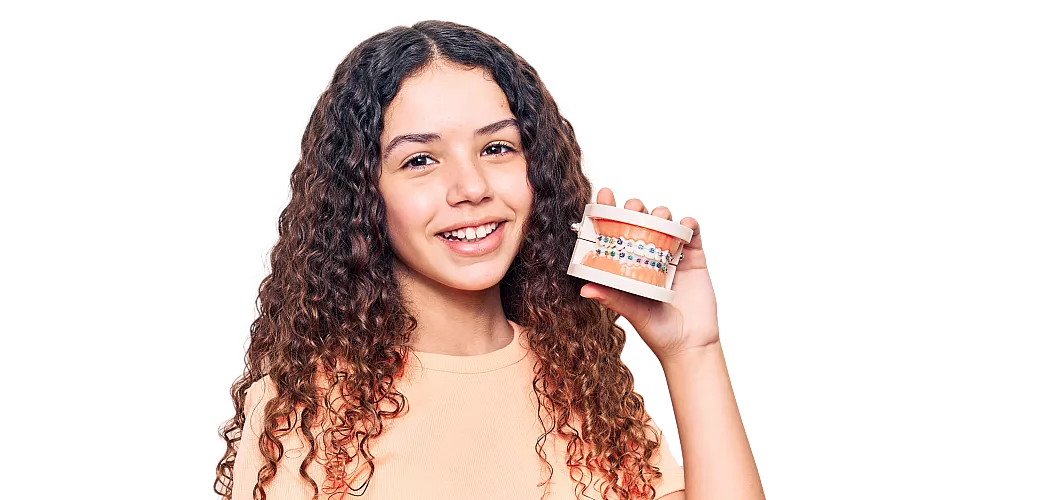
FAQs
You can find answers to all your orthondontics questions here.
Questions from our patients
Invisalign aligners are clear; no one may even notice that you’re wearing them, making Invisalign a seamless fit with your lifestyle and day-to-day interactions with others.
Invisalign aligners are removable.
Unlike braces, you have the flexibility to eat and drink what you want during treatment simply by removing the aligners when you eat. You can also remove the aligners to brush and floss as you normally would for fresh breath and good oral hygiene.
Unlike traditional braces, Invisalign does not use metal brackets or wires that could cause irritation to your mouth. In addition, you’ll spend less time in the doctor’s chair, and more time out doing the things you love.
If your lifestyle includes travel or if kids go to summer camp, Invisalign is great to keep your treatment on track.Your Orthodontist can work with your schedule so that you can usually get enough aligners for your trip – not delaying treatment. There are also fewer emergencies or extra visits to worry about while you are away.
Time for a snack? No problem. Take out your aligners to eat or drink whenever you want (but always be sure to remove your aligners when drinking any sugary or acidic drinks)
Since Invisalign is almost invisible, chances are that no one will even notice anything is different. You can remove your Invisalign aligners, so you can brush and floss regularly and keep your teeth and gums healthy.
There’s no need to change a thing. Continue your day-to-day activities while still straightening your teeth.
Be yourself with Invisalign. Since it’s clear, you don’t have to hide your smile while going through treatment.
With Invisalign, it’s easy to make your smile picture perfect for that special occasion.
Invisalign appointments work with your schedule. Most Invisalign appointments are short and your Orthodontist usually needs to see you every 10-12 weeks.
Phase I, or early interceptive treatment, is limited orthodontic treatment (e.g. expander or partial braces) before all of the permanent teeth have erupted. Such treatment can occur between the ages of six and ten. This treatment is sometimes recommended to make more space for developing teeth, correction of crossbites, overbites, and underbites, or harmful oral habits. Phase II treatment is also called comprehensive treatment because it involves full braces when all of the permanent teeth have erupted, usually between the ages of eleven and thirteen.
Sometimes. It really depends on the situation and that’s why an orthodontic evaluation is important. The overall space available for the teeth does not increase after the age of about 8 years old. In fact, the space available for the permanent teeth to grow in can actually decrease as the last baby molars fall out so the timing of orthodontic treatment can be very important.
Yes! There are very few foods that we recommend you avoid during your treatment due to the possibility of damage to the wires or brackets. Any damage can extend your treatment times, so we’d encourage you to stay away from foods like hard candy, caramel, and nuts. You can still enjoy many of your favourite foods, but your preparation of them might change. For example, you should cut hard vegetables into smaller pieces, and always ensure you brush and floss afterwards! With Invisalign, because the clear aligners are removable during meal times, you can eat all of your favourite foods!
- A more attractive smile
- Reduced appearance-consciousness during critical development years
- Better function of the teeth
- Possible increase in self-confidence
- Increased ability to clean the teeth
- Improved force distribution and wear patterns of the teeth
- Better long-term health of teeth and gums
- Guide permanent teeth into more favorable positions
- Reduce the risk of injury to protruded front teeth
- Aids in optimizing other dental treatment
This initial consultation offers you the chance to get acquainted with our team, explore the world of orthodontics, undergo a comprehensive examination, and identify the treatment options that best suit your needs. We will cover the following during your initial consultation:
- Examine your dental and medical history records
- Conduct a thorough oral examination, which may include digital photos and X-rays, to determine if treatment is required
- Assist in developing a tailored treatment strategy
- Discuss financial details, insurance choices, and payment plans
The position of the teeth, and sometimes entire facial structures, are permanently changed by orthodontic treatment. It is important that the situation be diagnosed properly, and that the treatment be appropriately and properly completed. Orthodontic specialists have the extensive and specialized training that enables them to provide their patients with the professional and personalized treatment that orthodontic treatment requires.
Simply call our office or book your consultation online. We will be happy to schedule an appointment for you. When you call to schedule your appointment, our front office staff will collect some basic information from you.
No, it is not. While many of our patients are indeed referred by their family dentist, many other patients take the initiative to schedule an examination themselves. We are happy to see new patients and give you our opinion.
Invisalign is a unique orthodontic system that straightens your teeth with clear plastic aligner trays, in place of wires and brackets. These aligners are custom-made for your smile, based on a treatment plan created specifically for you by your Orthodontist.
Over the course of your treatment, you will be provided with a number of trays, each tray making small changes to your tooth and jaw alignment. The aligner trays are designed in such a way that each will move your teeth into the desired position, as identified by your Orthodontist; because the trays are clear, they provide patients with a discreet approach to orthodontic treatment.
While you may experience some discomfort when the braces are first applied and after adjustments, this is usually temporary. Over-the-counter pain relief can help manage any discomfort, and most patients adjust to their braces within a few days.
Yes, some signs include early or late loss of baby teeth, difficulty chewing or biting, mouth breathing, and crowded or misplaced teeth. If you notice any of these, it's a good idea to consult with an orthodontist. .
Candidates for braces or Invisalign include individuals with crowded teeth, gaps, overbites, underbites, or other alignment issues. Your orthodontist will determine the best treatment option based on your specific needs.
The duration of orthodontic treatment varies depending on the complexity of the case. On average, treatment with metal braces can take between 18 to 24 months, but your orthodontist will provide a more accurate timeline during your consultation.
It’s recommended to bring your child for an consult with an orthodontist around the age of 7. Early assessment allows the orthodontist to identify potential issues and determine the best time to start treatment.
